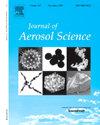Statistical signal analysis for optical aerosol spectrometers: Closing the gap between single particle counting and signal fluctuation analysis
IF 2.9
3区 环境科学与生态学
Q2 ENGINEERING, CHEMICAL
引用次数: 0
Abstract
Light scattering aerosol spectrometers (also known as optical particle counters, OPCs) are widely used for aerosol quantification. The single particle counting method, which is based on light scattering, can measure the size distribution and the number concentration of the sampled aerosol. However, this method is limited to low concentrations due to coincidence error. At higher concentrations, the particle pulses overlap and cannot be counted individually. It was recently shown that the detector signal of an optical aerosol spectrometer can also be evaluated by fluctuation analysis if the concentration is significantly higher than the coincidence limit of the device. This new mode of operation cannot yet provide a detailed size distribution but itis feasible to measure the median particle size and number concentration independently. The measurement information required for fluctuation analysis is drawn from the intensity distribution of the detector signal instead of individual pulses. Therefore, fluctuation analysis requires a certain average number of particles inside the measuring volume so that the detector output continuously leaves the baseline. Theminimum number concentration of the fluctuation analysis is around a factor of20 higher than the coincidence limit for single particle counting. Consequently, there is a concentration range where neither single particle counting, nor fluctuation analysis can be used.
This work introduces a new statistical signal analysis to bridge this gap. The new measurement method was experimentally verified using a monodisperse di-ethyl-hexyl-sebacat aerosol with a particle size range of 0.3 µm to 2.2 µm and a number concentration range of 1 104 cm−3 to 2 105 cm−3. An accuracy of 2 % with respect to median particle size and 5 % with respect to number concentration was achieved. The new method finally closes the gap between single particle counting and fluctuation analysis, enabling light scattering aerosol spectrometers to quantify aerosols at any given concentration.
光学气溶胶光谱仪的统计信号分析:缩小单粒子计数和信号波动分析之间的差距
光散射气溶胶光谱仪(也称为光学粒子计数器,OPCs)广泛用于气溶胶定量。基于光散射的单粒子计数方法可以测量采样气溶胶的大小分布和数量浓度。然而,由于符合误差的存在,该方法仅适用于低浓度。在较高的浓度下,粒子脉冲重叠,不能单独计数。最近的研究表明,当浓度显著高于仪器的符合极限时,光学气溶胶光谱仪的探测信号也可以用波动分析来评价。这种新的操作模式还不能提供详细的粒径分布,但可以独立测量中位数粒径和数浓度。波动分析所需的测量信息是从探测器信号的强度分布中提取的,而不是从单个脉冲中提取。因此,波动分析要求测量体积内有一定的平均粒子数,使探测器输出连续地离开基线。波动分析的最小粒子数浓度比单粒子计数的符合极限高20倍左右。因此,存在一个既不能使用单粒子计数也不能使用波动分析的浓度范围。这项工作引入了一种新的统计信号分析来弥补这一差距。采用粒径范围为0.3µm ~ 2.2µm、数值浓度范围为1 × 104 cm−3 ~ 2 × 105 cm−3的单分散二乙基己基癸二酸气溶胶对该测量方法进行了实验验证。对中位粒径的准确度为2%,对数字浓度的准确度为5%。新方法最终缩小了单粒子计数和波动分析之间的差距,使光散射气溶胶光谱仪能够定量任何给定浓度的气溶胶。
本文章由计算机程序翻译,如有差异,请以英文原文为准。
求助全文
约1分钟内获得全文
求助全文
来源期刊

Journal of Aerosol Science
环境科学-工程:化工
CiteScore
8.80
自引率
8.90%
发文量
127
审稿时长
35 days
期刊介绍:
Founded in 1970, the Journal of Aerosol Science considers itself the prime vehicle for the publication of original work as well as reviews related to fundamental and applied aerosol research, as well as aerosol instrumentation. Its content is directed at scientists working in engineering disciplines, as well as physics, chemistry, and environmental sciences.
The editors welcome submissions of papers describing recent experimental, numerical, and theoretical research related to the following topics:
1. Fundamental Aerosol Science.
2. Applied Aerosol Science.
3. Instrumentation & Measurement Methods.
 求助内容:
求助内容: 应助结果提醒方式:
应助结果提醒方式:


